VIZIO 2019 P-Series Quantum X 4K HDR TV (PX65-G1)
Overview -Overview -- Serving as VIZIO's flagship 2019 display, the P-Series Quantum X 4K HDR TV features quantum dot color, full array local dimming with 384 zones (65-inch model), Dolby Vision/HDR10 support, and over 2,000 nits of peak brightness in Calibrated mode. But while overall HDR performance is nearly unmatched here for a TV in this price range, the panel does suffer from some relatively minor but still noteworthy issues related to blooming, banding, and uniformity. Likewise, the SmartCast platform's on-screen app lineup remains limited and navigation is rather sluggish compared to other smart TV systems. At a current sale price of just $1,600, however, the TV easily cements itself as one of the absolute best values on the market. Highly Recommended.
Intro
Positioned as the successor to the company's 2018 P-Series Quantum TV, the new P-Series Quantum X serves as a worthy successor to that previous flagship set while also offering a solid step-up from VIZIO's other 2019 models.
Carrying over the same quantum dot tech used throughout the Quantum lineup, the P-Series Quantum X improves upon its less expensive siblings by offering the highest HDR brightness capabilities of the lineup, with up to 3,000 nits of peak brightness (in Vivid mode) compared to the P-Series Quantum's 1,200 nits and M-Series Quantum's 600 nits. Likewise, the Quantum X display also includes the highest local dimming zone count of the bunch, with up to 480 zones on the 75-inch model versus the max 240 and max 90 zones found on the P-Series Quantum and M-Series Quantum.
The P-Series Quantum X is available in 65-inch (MSRP $1,699, currently $1,599) and 75-inch (MSRP $2,699, currently $2,399) screen sizes.
Specs & Design
For this review, we received the 65-inch version of the P-Series Quantum X 4K HDR TV. The display uses a VA LCD LED panel with a 16:9 aspect ratio, an Ultra HD resolution of 3840x2160, and a 120Hz native refresh rate. In addition, the panel features full array local dimming with 384 zones (480 on the 75-inch). Likewise, Dolby Vision, HDR10, and HLG high dynamic range playback capabilities are included as well, along with quantum dot technology for nearly 100% coverage of the DCI-P3 wide color gamut.
Presenting a slightly more premium look compared to the step-down 2019 P-Series Quantum, the Quantum X employs a virtually bezel-free design with thin black borders around the entire panel. The side of the screen features a silver textured trim and the back of the panel offers a black textured plastic construction. The unit's profile measures about 2.7" at its thickest point. Detachable silver metal left and right feet stands are included as well.
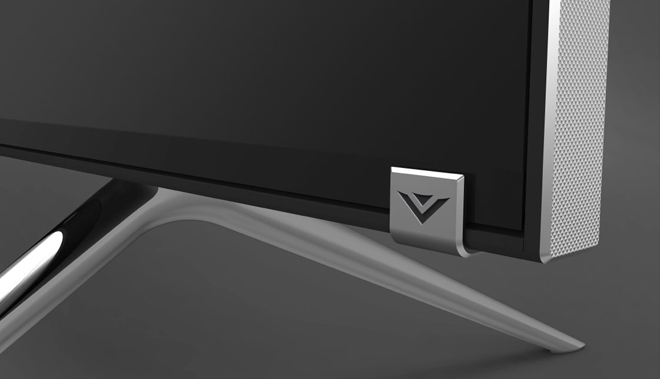
With the feet attached, the TV measures 56.96" x 35.11" x 11.81", and weighs 54.9 Lbs. Three HDCP 2.2 compliant HDMI 2.0b inputs (including one ARC), optical and analog audio outs, a cable/antenna input, and an Ethernet port are all located on the back toward the bottom right. In addition, a USB port, Component/Composite inputs, an additional HDMI 2.0b input, and one HDMI 1.4 port are located on the right side of the panel. Meanwhile, the power connection is housed on the bottom left side.
Under the hood, the display is powered by an Octa-Core Processor running the SmartCast 3.0 platform and supports 802.11ac Dual Band Wi-Fi connectivity. In addition, the package comes with the same simple black click button remote included with the step-down Quantum models. While perfectly functional, a remote with a slightly more premium build might help to further set this flagship model apart from the company's other offerings. And sadly, VIZIO remains one of the only TV manufacturers to not offer integrated voice control on any of its remotes.
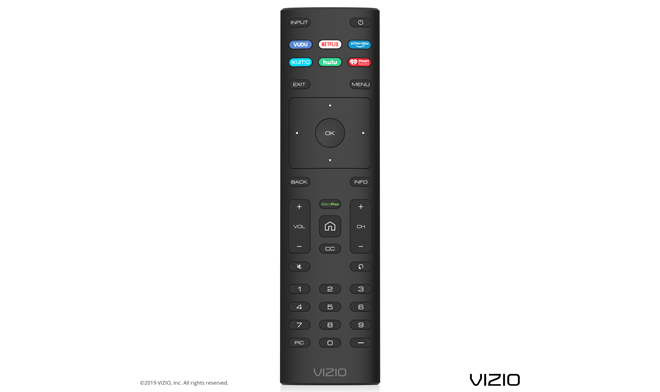
Like other SmartCast models, users can also control the display via the SmartCast mobile app for iOS and Android devices. And while the TV does not include a voice remote, voice control for select commands is still supported via a separate Amazon Alexa, Google Assistant or, new for 2019, Apple Siri device
Finally, for those without a separate audio setup, the TV features integrated 10w x 2 speakers. They get the job done for casual viewing but most customers will want to upgrade to an external sound bar or full surround sound system for more enveloping home theater performance.
Setup
After getting the feet attached, hooking up your components, and powering on the display, the setup process guides viewers through the usual assortment of basic configuration and housekeeping settings, including prompts for language selection, Wi-Fi info, and various terms of service and privacy policies. Likewise, the TV will automatically scan for and apply updates after establishing an internet connection.
During my evaluation, I primarily used the TV with an Onkyo TX-NR555 AV receiver connected to the display's HDMI ARC (audio return channel) input, allowing the receiver to pass-through full bandwidth 4K Ultra HD Dolby Vision/HDR10 content to the screen and the display to transmit audio from its apps to the receiver. In addition, I hooked up an LG UP970 4K Ultra HD Blu-ray player and a Sony UBP-X800M2 4K Blu-ray Player to the receiver, and an Amazon Fire TV Stick 4K directly to the TV's HDMI 2 input. Likewise, I also subbed out the receiver for a Sony HT-S350 Sound Bar during some of my evaluation.
With ARC and CEC (consumer electronics control) enabled in the menu, the display automatically recognized that a receiver, Fire TV Stick, and sound bar were connected and used those corresponding labels for their HDMI inputs. Thanks to CEC, I could also use the TV's remote to adjust the receiver and sound bar volume. Likewise, the display was capable of successfully sending Dolby Atmos audio from compatible SmartCast apps like VUDU and Amazon Prime Video to the receiver. In addition, Atmos was also correctly passed from the Fire TV Stick to the receiver using the TV as a go between. Thankfully, I did not encounter any notable signal or AV sync issues with the display and my components.
When it comes to picture calibration, the PX65-G1 offers a comprehensive assortment of adjustments and settings. In general, the Calibrated Dark preset with all unnecessary enhancement options deactivated and Local Dimming set to Medium will provide the most accurate out-of-box HDR10/Dolby Vision playback with the best balance between brightness and black levels suitable for a home theater setting. Meanwhile, those same settings with Local Dimming set to Low will provide the most accurate out-of-box SDR playback for a home theater environment. Of course, if one desires to perform a full white balance and greyscale calibration, the TV offers more than enough control to fine tune things even more.
Local Dimming
Like other VIZIO sets, the P-Series Quantum X makes great use of its Full Array Local Dimming backlight. This technology utilizes LED light sources positioned in multiple dimmable zones across the TV's panel, allowing the screen to brighten or darken in selected spots to coincide with the content being played. As a result, the display is able to achieve deeper black levels and more precise HDR highlights compared to edge-lit models or LCDs without any dimming.
The effectiveness of local dimming is based largely upon how many zones a manufacturer is able to implement in their panel (typically, the more the better) and the particular algorithm a company uses to tell those zones how to operate. Doubling the 192 zones found on last year's P-Series Quantum, the new 2019 P-Series Quantum X comes equipped with a whopping 384 zones (the 75-inch model offers an even more impressive total of 480).
And in general, the increase in zones over the 2018 model does indeed result in some welcomed performance improvements. With that said, some of the issues I encountered on last year's P-Series Quantum are still present here to a lesser degree, leading to some relatively minor but still noteworthy quirks related to blooming.
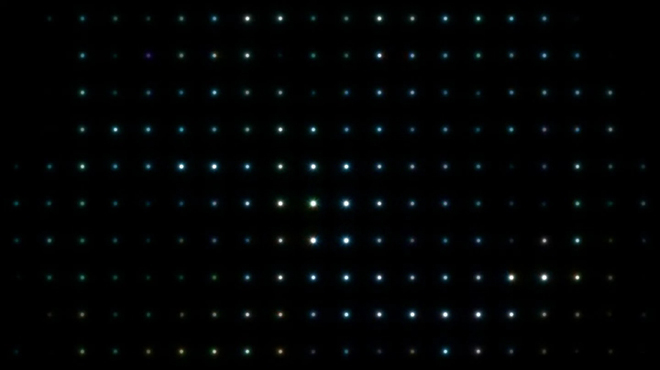
(Note: above picture does not accurately represent the number of zones on the display)
Like the 2019 standard P-Series Quantum, overall black level performance is improved over 2018 VIZIO TVs, enabling the display's blacks to achieve a pleasingly inky quality in a completely dark room with both SDR and HDR signals. With that said, the Quantum X's blacks look like they might be just a hair lighter than those produced by the step-down 2019 P-Series Quantum. Likewise, some local dimming sets from TCL and Samsung are capable of getting even darker, but the difference is very small during real-world playback.
As a whole, the dimming is able to produce fantastic contrast with precise HDR highlights and very little light bleed to black bars in wide-screen movies. But as great as the full array backlight operates with most content, I actually ended up noticing the zones at work a bit more here than I did with the step-down 2019 P-Series Quantum model I previously reviewed. This might have something to do with the increased brightness output on this model.
On the one hand, instances of traditional blooming around bright objects when placed against black backdrops were almost completely absent during my testing. For example, a potentially problematic sequence set in a dark dungeon in Game of Thrones was rendered without any noticeable halos.
On the other hand, the TV was still occasionally prone to blueish blooming around objects and characters set against grey or more neutral colored environments. HDR content with comparatively undersatured or cool palettes like Carnival Row, When They See Us, and The Haunting of Hill House were particularly susceptible to this quirk, causing noticeable blueish halos to appear in certain scenes. Likewise, transitions from zone to zone were visible in various scenes on titles like Godzilla: King of the Monsters during pans and camera movements, causing a flickering quality around some objects. Meanwhile, blueish halos were also evident around logos and loading icons in various app menus.
To be clear, artifacts like this are present to some degree on all local dimming TVs, and the blueish blooming issue has indeed been reduced here compared to the 2018 P-Series Quantum model which was even more susceptible to this problem. Despite understandable flaws here and there, when stacked up against other leading 2019 full array LCDs, the P-Series Quantum X's local dimming still performs very well.
Performance
To demo the PX65-G1 Dolby Vision, HDR10, and SDR picture performance, I sampled a variety of 4K Ultra HD Blu-ray discs, Blu-ray discs, and streaming content from services like Netflix, Amazon Prime Video, and VUDU, including titles like Godzilla: King of the Monster, Jumanji: Welcome to the Jungle, The Matrix, Blade Runner, Kong: Skull Island, Wonder Woman, The Lego Batman Movie, Game of Thrones, When They See Us, Carnival Row, Stranger Things, Cobra Kai, Spears and Munsil's 4K Calibration Disc and more.
According to VIZIO's spec sheet, the 65-inch P-Series Quantum is capable of a maximum peak brightness of 3,000 nits. With that said, that number is only possible in the Standard or Vivid picture modes. Using the Calibrated Dark mode (the best for an accurate image), however, the display was still able to achieve an incredible peak brightness of about 2,400 nits with the Medium local dimming setting, offering some of the highest HDR brightness performance available. And complementing its fantastic nit output, the display also uses quantum dot tech to provide close to 100% DCI-P3 wide color gamut coverage and about 84% BT 2020 coverage.
Making the most of those fantastic specs, the P-Series Quantum X did not disappoint when it came to actual picture performance, providing some of the most striking HDR imagery I've seen on an LCD set, creating an often gorgeous image marked by sumptuous colors, deep blacks, and impeccable clarity.
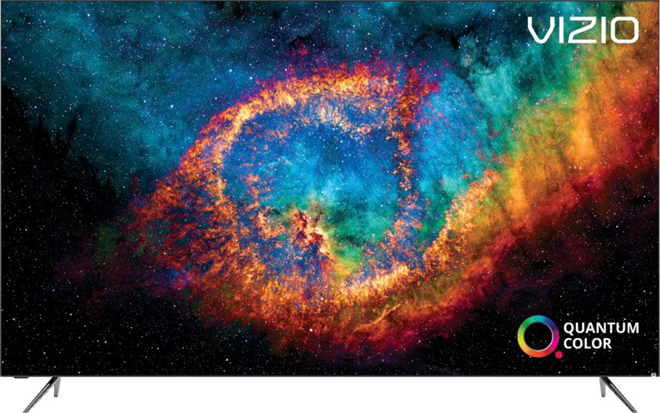
Dolby Vision content like Jumanji: Welcome to the Jungle and The Matrix looked especially impressive with fantastic contrast. The opening scene of The Matrix presented intense highlights in flashlights and glowing green code without obscuring detail. Likewise, the set was able to maintain deep blacks without blooming. Meanwhile, the lush green jungle in Jumanji came through with colorful yet still natural saturation.
Clips from The Lego Batman Movie, Kong: Skull Island, Stranger Things, and Dolby demo disc content like the CG animated short Escape, all looked fantastic through the Quantum X as well, fully showcasing the benefits of the display's impressive brightness capabilities. Speculars in larger elements like massive explosions and big shining lights carried a powerful kick, achieving a degree of full-screen brightness that other LCDs and OLEDs simply can't match.
The Spears and Munsil demo reel also looked rather stunning here, with intricate textures and fine detail readily visible across the clip's varied landscapes, nature, animal, and cityscape images. One shot of a sunset was especially telling, with realistic reflections shining from the water below. Likewise, the sun itself was cleanly rendered with intense brightness and a clearly defined shape free from any loss in specular detail.
And beyond 4K HDR material, the set also excelled at scaling 1080p SDR content, offering fantastic Rec. 709 color coverage and great contrast with even less visible dimming artifacts when watching standard Blu-rays, YouTube clips, or CNN streaming.

With that said, as fantastic as most content appeared, the P-Series Quantum X was prone to some occasional issues related to false-contouring/posterization during a few titles I demoed, resulting in sporadic instances where gradients appeared blockier and less smooth than they typically have on some other displays.
Banding was particularly troublesome in one sequence on the 4K Ultra HD Blu-ray release of Ex Machina where two characters converse under harsh red lighting. This scene seems to be problematic on a lot of TVs (likely partially a result of compression issues with the source disc itself), but the posterization appeared far worse here than it has on several other displays from LG, Samsung, and TCL. Likewise, I noticed some banding artifacts in skies on the 4K Spears and Munsil demo disc reel that weren't present on some other TVs I've tested recently.
False contouring was also frequently visible on 4K HDR streaming content from apps like Amazon -- but while source compression is definitely more of a cause for that than the panel itself, these flaws appeared to be exacerbated here more than they have on some other TVs I've tested.
To be clear, however, panel gradient issues were definitely more the exception rather than the rule, and the majority of the content I watched featured smooth imagery. Despite imperfections here and there, when it comes to overall HDR and SDR picture performance, the P-Series Quantum X really did shine -- literally and figuratively -- with punchy HDR highlights that offered a bit more depth and intensity to images compared to LCDs with less robust brightness capabilities.
Uniformity, Viewing Angles, & Reflections
When it comes to overall screen uniformity, the PX65-G1 ended up offering some mixed results. On the plus side, troublesome shifts in hue across the panel proved to be very minimal. Likewise, darkening around the corners (something common on local dimming LCDs) was also surprisingly negligible.
Unfortunately, however, vertical lines with slight discrepancies in brightness were visible across the panel in certain real-world content. The seams were particularly noticeable on the right side of the screen during pans in scenes with lighter backgrounds.
Vertical uniformity flaws like this are actually pretty common for a lot of display models and tend to vary from panel to panel. With that in mind, it's possible other P-Series Quantum X units will be less affected by this. As it stands, though not a major problem for the majority of my testing, the vertical lines on this particular set were a bit more noticeable than I would have liked.
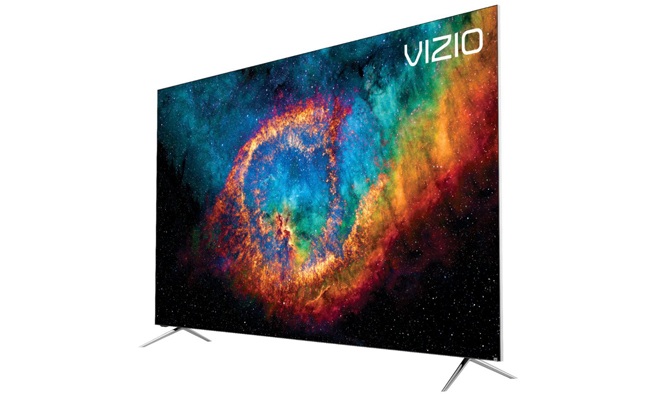
Outside of uniformity, viewing angles appeared to be improved a little on this year's display versus last year's. Colors still distorted and washed out when viewed from an off-angle position, though, and there were some occasional shifts in hue on the edges of the screen even from a centered position -- but these instances were less prevalent than they were on the 2018 P-Series Quantum. With that said, blooming still became much more noticeable from an off-angle vantage point.
A special "Enhanced Viewing Angle" option is also offered in the menu. This setting is supposed to help improve off-axis viewing but in practice I found that the feature didn't really provide any substantial benefits.
Finally, the screen handles reflections very well, offering good performance in brighter rooms. Of course, direct reflections, like those caused by windows across from the TV in my living room, could still present issues when the curtains were pulled back, but in general the panel should make a great fit for almost any environment.
SmartCast, AirPlay 2, and Voice Control
As I said in my review of the standard 2019 P-Series Quantum, the SmartCast platform continues to be a bit lacking compared to some other smart TV interfaces. The OS offers on-screen access to select apps like Netflix, Amazon Prime Video, YouTube, Hulu, VUDU, FandangoNOW, iHeart Radio, VIZIO's WatchFree service powered by PlutoTV, and more. Likewise, Dolby Vision and HDR10 support are included for most applicable services.
A host of additional apps can also be viewed on the TV from a separate mobile device or computer via Chromecast and newly added support for Apple AirPlay 2. But while that is a nice feature, I would still prefer to have access to a full app selection right on the TV's interface.

Beyond apps, the SmartCast screen also includes header sections for Movies and Shows, as well as a universal search function. Actual playback, whether from the on-screen selection or via casting worked well with no major issues to report. With that said, on-screen navigation remains slow compared to some other smart TV interfaces with some lag here and there.
Finally, the SmartCast OS also supports a nice selection of voice control options, including compatibility for hands-free commands via a separate Amazon Alexa, Google Assistant, or Apple device.
Final Thoughts
Pros
- Impressive overall 4K HDR and HD SDR performance
- Dolby Vision, HDR10, and HLG support with 2,400 nits peak brightness (Calibrated Mode)
- Wide Color Gamut capabilities with quantum dots
- Full-Array local dimming with 384 zones and deep black levels
- Voice control via separate Alexa, Google Assistant, or Siri devices
- AirPlay 2 support for streaming Apple TV app content
- Good price to performance ratio
Cons
- SmartCast platform remains sluggish with limited on-screen app selection
- Blueish blooming evident in certain content
- False-contouring/posterization visible in select material
- Some faint vertical uniformity flaws
- Overall contrast and viewing angles still can't equal OLED performance
- Lacks HDMI 2.1 ports
The VIZIO P-Series Quantum X offers genuine flagship 4K HDR performance with over 2,000 nits of peak brightness in calibrated mode, nearly 100% coverage of the P3 wide color gamut, Dolby Vision support, and full array local dimming with 384 zones for precise highlights and great black levels.
With that said, blueish blooming and zone fluctuations are visible from time to time and the screen can be prone to posterization and gradient issues in certain content. Likewise, though decent for a VA panel, viewing angles are still mediocre and there are some minor uniformity problems. And though it gets the job done, the SmartCast platform's on-screen app selection remains comparatively limited and navigation is a bit sluggish.
Still, despite those flaws, the P-Series Quantum X's picture quality is quite striking for this price range. There are some aspects of the step-down standard 2019 P-Series Quantum TV's black level, local dimming, and gradient performance that I actually prefer over the Quantum X's, but as a whole, the higher brightness output here does provide an appreciable upgrade for HDR playback.
VIZIO appears to have recently lowered the Quantum X's MSRP to $1,699 and is currently offering the display for a sale price of $1,599. Though there are a couple LCD and OLED sets with better overall picture quality for more money, when stacked up against other 65-inch TV options under $2,000, the PX65-G1 is Highly Recommended.












